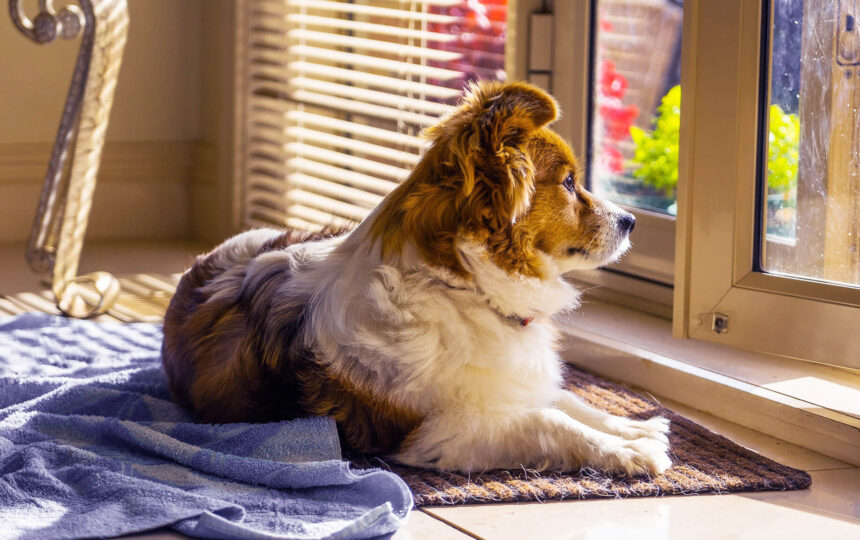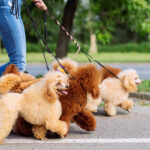Has your senior dog not been acting like himself? Perhaps he no longer leaps with joy to greet you when you get home from work or doesn’t seem interested in the toys that used to bring him joy.
Dogs, like humans, are living longer. Living longer than their wild ancestors means more time for age-related conditions to develop – especially cognitive issues.
According to research, a dog’s risk of developing dementia increases by 50% yearly. Approximately 68% of dogs over the age of 15 have CDS.
Like humans, aging dogs can suffer from “senior moments,” where they space out or behave out of character. Canine cognitive dysfunction (CCD) is a real and serious condition in dogs, similar to Alzheimer’s in humans.
This condition devastates dogs and their pet parents, who are deeply saddened by losing their once lively and engaged furry friend. But how do you know if your canine companion is suffering from cognitive decline?
According to Dr.Denise Petryk, DVM, there is a commonly used acronym that helps with diagnosing cognitive failure – DISHA
- Disorientation
- Interaction changes
- Sleep issues
- House soiling
- Activity level changes
If you suspect a cognitive issue with your canine companion, use the following score to make an assessment.
0 = no signs
1 = mild signs
2 = moderate signs
3 = severe signs
A total score between 4-15 = mild CCD
A total score between 16-33 = moderate CCD
A total score of more than 33 = severe CCD
If only dogs could talk, right? Since they can’t, it is essential to know what to look for that will help you get the proper diagnosis and best care for your senior pup. Changes may occur slowly and over a long period, so it is important to check your pet’s behavior frequently and watch for these signs.
Disorientation and anxiety
Signs that your pup is disoriented may include going to the wrong door to be let outside or simply standing and staring at the dog door instead of pushing it open.
Other signs that your pup is suffering from spacial awareness dysfunction include getting stuck behind furniture and not being about to back themselves out.
You may also sense an increase in anxiety in your dog. He may whine when you leave the room, or is left alone, or seem highly bothered by things that have never bothered him before. Pacing, another indicator of anxiety, is also common in dogs with CCD.
Changes in interaction
Take note if you notice your dog not interacting with people in the home or other pets in the usual way. Perhaps he doesn’t want to play with other household furry friends, is slow to come when you call, or hides when friends come over.
He does not dash for the door when someone rings but just lays in one spot – seemingly uninterested in his surroundings. Does your dog usually spin in circles when you grab his leash for a walk but now not even notice you have the leash in hand?
Some dogs are just shy, but if your pup was once the life of the party and suddenly stops acting like this, it is a sign that something is wrong.
Other medical things, such as joint pain, injury, or another painful condition, could be happening. A trip to your vet will rule anything out any of these.
Accidents in the house
We expect the odd accident here and there when training young dogs, but if your senior pup suddenly starts using the living room carpet as his toilet, something is up.
According to Dr. Petryk, accidents in the house are one of the most common signs of CCD. Look for signs that your dog has lost his ability to understand that he needs to go outside to use the bathroom, like staring out the door and urinating or defecating at the same time.
Dr. Petryk says that a number of tests may be run to rule out other causes of house soiling first before jumping to CCD as the root reason for the issue.
“After we run tests and rule out a bladder infection, kidney problems or diabetes, then there’s usually been a cognitive change. If your dog is staring out at the sliding glass door and then poops in the house anyway, and it’s not because of bowel trouble; he’s lost the understanding that he should poop outside.”
Disrupted sleep-wake cycle
Dogs suffering from CCD often deviate from a normal sleep-wake cycle. You may find your furry friend pacing the house at night and sleeping inactive all day. This switching of the night for day and vice versa is very common in pets struggling with cognitive impairment.
Reduced interest in physical activities
Even senior dogs who were once highly active can become lethargic and uninterested in chasing their favorite ball or snatching a frisbee out of the air when cognitive dysfunction sets in.
Additional signs of cognitive decline
In addition to the above, you may notice many other changes in your dog.
Reduced appetite
Some dogs suffering from cognitive dysfunction have difficulty finding their food bowls and eating or drinking. They may start to eat only or drink only to drop pieces of food on the ground unnoticed.
If your pup turns his nose up at their favorite treats, it might not be because they don’t like them but because they no longer recognize them. Before you run out and buy new treats, run through the CCD assessment.
Repetitive and restless motions
A common indicator of cognitive dysfunction or brain degeneration is repetitive movements. Your dog might bob his head, shake his leg, or pace around in circles – as mentioned above.
How to help your cognitively challenged pup
Although there is no cure for dog dementia, there are a few things that you can do to help your pup be more comfortable and help alleviate symptoms of CCD.
Keep your pup engaged
Make time to spend with your canine companion daily, challenging him with interactive games and play. Food puzzles and snuffle mats are an excellent way to keep dogs engaged. You can also hide treats throughout your house and play a game of supervised hide and seek with your pet.
Create a safe environment
Because dogs with dementia often wander around, it is important to block off any areas in your house that may be a hazard, such as stairways. If you have furniture close to walls or positioned in a way that your pup might get stuck, make the necessary adjustments so he can pass freely behind.
Routine and familiarity matter
Whether struggling with CCD or not, senior dogs appreciate a set routine. Sticking to the same schedule and routine for meals walks, and bedtime will give your pet regularity which will calm anxiety. Keep food and water bowls in the same location. Daily walks help eliminate accidents in the house.
Feed a raw food diet
Research shows that nutrition is vital for brain function and behavior in dogs. Conventional dog food contains fillers and chemicals that contribute to an aging brain.
In contrast, foods rich in healthy proteins, fats, vitamins, and minerals support healthy brain functions.
According to veterinarian Dr. Richard Pitcarin,
“Commercial pet foods don’t contain some things we wish they did: adequate quantities and qualities of proteins, fats, vitamins, and minerals, as well as the more intangible qualities unique to live, fresh foods.”
Switching to a raw diet will give your senior pup essential nutrients and antioxidants to power the brain. Look for high-quality food that contains everything needed for a balanced diet.
Make the switch slowly so as not to upset your pup. Introduce the new food with the old diet over a week or two, gradually reducing the amount of the old diet and increasing the amount of the new.
Be patient with your old friend
Senior dogs are unique, and those that develop CCD are extra special and require special care and patience. If you suspect your furry friend is experiencing cognitive decline, a trip to your veterinarian is in order. They will provide a diagnosis and tools to help you and your pet adjust to the new normal.






